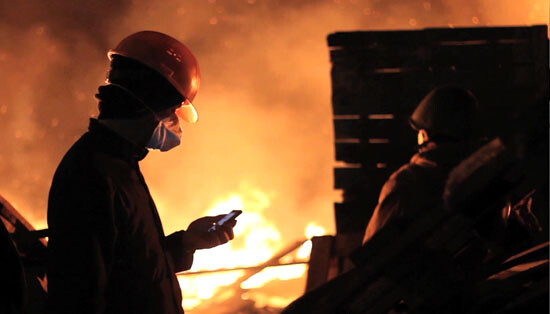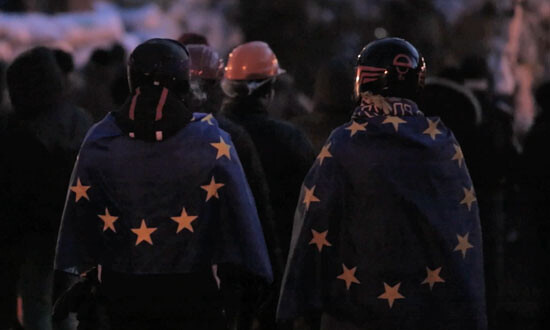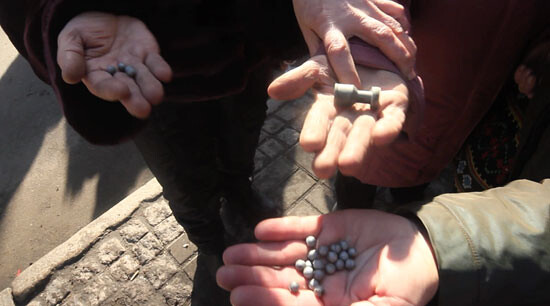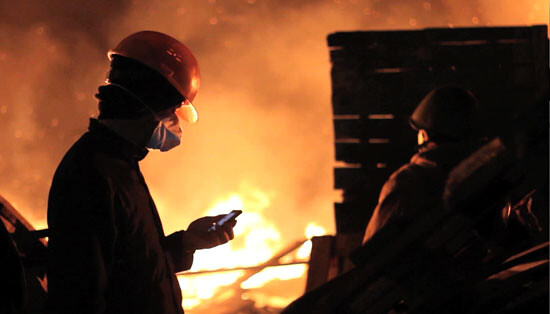1.
On November 21, 2013, Ukrainian journalist Mustafa Nayem posted a call on Facebook to gather at Maidan square in Kyiv, a common site for civic dissent: “If you really want to do something, don’t just ‘like’ this post. Let’s meet at 10:30 p.m. near the monument of independence in the middle of the Maidan.”1 Nayem called for the protest after the Ukrainian government announced earlier that day that it would not sign a trade agreement with the European Union, and would halt further integration with Europe. This may seem like an unusual reason to rise up. But what started as an apparently minor attempt by the tiny Ukrainian creative class to carry out another “social media revolution” rapidly developed into a gigantic people’s uprising centered on Maidan square in Kyiv.2 It lasted for several months and resulted in hundreds of casualties, the violent overthrow of the regime, and the subsequent reshaping of the world map.
Scholars of social media may interpret the Maidan uprising as a brilliant example of how Facebook helped people start a revolution without resorting to a military coup or self-immolation. Yet it is all too easy to claim that everyone is Adbusters now. There is another, less enthusiastic view of the role of social media in world politics. For adherents of this view—such as Vladimir Putin and his ultra-nationalist supporters—the launching of the Maidan uprising was part of a covert Western plot to overthrow the reigning political regimes in the post-Soviet world. According to this view, just as the suicide of Mohamed Bouazizi was aimed directly at toppling not only Ben Ali of Tunisia but also Hosni Mubarak of Egypt and Bashar al-Assad of Syria, Mustafa Nayem’s Facebook post aimed ultimately to overthrow not just Victor Yanukovych of Ukraine, but also Aleksandr Lukashenko of Belarus, Nursultan Nazarbayev of Kazakhstan, and of course Vladimir Putin himself.


Disturbingly, the proponents of this theory are the same ones hosting Edward Snowden in exile and publishing Slavoj Žižek in Russian.3 They also possess one of the world’s largest nuclear arsenals. The theory is just one of the many components of Putin’s propaganda machine, which has allowed him to plunge Russian society into an anti-Western, militaristic hysteria, while he simultaneously tries to persuade the Western public that the real fascist threat now comes from the decaying post-Maidan interim government in Kyiv—and not from Russia itself. Meanwhile, the Russian government has expropriated sovereign territory, endorsed pro-Russian irredentist terrorists in Ukraine, staged spoof referendums, racially segregated Crimean Tatars in occupied Crimea, and pursued an ethnicization of international politics based on Russia’s alleged need to protect its apparently endangered Volksgenosse across the former USSR.
The scale of conspiratorial thinking in Russia is now comparable to that of the US after 9/11.4 But the problem with conspiracy theories is not the fact that they are false products of a paranoiac imagination, but rather that some conspiracies do exist. To reject this means to turn a blind eye to one of the many important tools of world politics. It thus seems crucial to avoid a simplistic opposition between middlebrow paranoiac thinking, and apparently enlightened reason unaware of its own blind spots. Thus, the first step toward a proper understanding of the Maidan movement in Ukraine is to replace the dominant question What is behind this? with the question What is beyond this?


2.
On November 30, 2013, Ukraine’s elite riot police, the Berkut, attacked the pro-EU encampment in Maidan square, violently dispersing the protesters and seriously injuring dozens of them. This attack turned out to be a powerful jolt for the Maidan movement, which by that time was already in decline and would have probably ceased to exist in a matter of days if the police had not intervened. After the attack, what had started as a peaceful, liberal, pro-globalization student movement transformed into an all-encompassing uprising that grew increasingly violent and at times nationalist, all the while invoking “Western values” and EU symbols.
The Maidan movement has brought into stark relief not only the issue of Ukrainian identity, but also the issue of European identity. The irony is that the Maidan protests, the “biggest pro-EU demonstrations in history,” were comparable in size to the anti-austerity, anti-EU protests that have shaken Southern Europe. It turns out that the same political structures and institutions that are loathed by many Europeans inside the EU, are genuinely praised and desired by numerous Europeans on its outside—simply because their lives are incomparably more miserable than the lives of the most aggrieved victims of European unification. Although Ukraine’s courtship of Europe has looked like a tiresome attempt by an underclass admirer to charm an upper-class beloved by constantly praising her values and accomplishments, the West can nonetheless recognize in the Ukraine conflict many of its own antagonisms in a condensed, crystallized form.
For instance, the violent methods of the infamous Berkut forces are not unknown to riot police in Europe and the US, where dissenters experience comparable violence. This is not to suggest that the scale of police violence carried out in Ukraine is in any way similar to that carried out in countries beyond its Western border; in recent years, police aggression has become an everyday reality for many Ukrainians. The police apparatus has increasingly merged with the criminal underworld. Blackmail and forced bribery are the day-to-day business of the police. The abduction and killing of detainees at police stations throughout the country is rarely investigated or even documented. But ironically, the Maidan protesters, who did not experience the joys of kettling or mass arrest, waved EU flags without knowing that in the EU itself, the response to their protest might have been only a shade less violent.
In his 2011 documentary All Watched Over by the Machines of Loving Grace, Adam Curtis gives an account of Ukraine’s 2004 Orange Revolution—a popular protest against electoral fraud and an important precursor to the 2014 Maidan uprising.5 According to Curtis, the Orange Revolution was part of the wave of newfangled uprisings—leaderless, self-regulating, largely organized via the internet—that puts them in the same context as the Occupy movement and the Indignados. For any viewer of the film who actually participated in the Orange Revolution, this account is very surprising. The Orange Revolution had strong, highly influential leaders. It was primarily organized by opposition parties and politicians. And it took place before social media started to have any significant impact on Ukrainian society. Curtis’s reading of the Orange Revolution actually applies more to events in Kyiv in 2013–14, three years after his film was completed.
The Maidan uprising was largely spontaneous. It may have even come as a surprise to the official opposition, which over and over again during the protests lost its grip on the dissenting masses. Although the uprising did have some leaders, their authority and credibility was constantly questioned and subverted by various grassroots groups and movements. Participants in the Maidan uprising displayed an outstanding skill for self-organization, sustaining the huge protest camp in Kyiv’s main square for three months amidst increasing legal repression, constant abduction, and violence from police. At the same time, there were some fairly frightening aspects to the Maidan uprising turned. In addition to providing many thousands of supporters with food, relative safety, and accommodations on a daily basis for several months, many participants in the Maidan uprising occupied their spare time with paramilitary training, national and religious rituals, and a hunt for internal enemies. As if to illustrate Adam Curtis’s critique of self-organized grassroots movements, the Maidan protesters reproduced many of the hierarchies that existed outside their temporary autonomous zone in the middle of Kyiv. Although Maidan never did pick a leader, the movement’s self-defense units, which grew increasingly paramilitary in response to mounting violence from police, started to resemble miniature totalitarian entities. These units—called “hundreds,” referring to the number of participants—play out a kind of postmodern identity politics, since most of them were formed on the basis of regional, occupational, or symbolic affiliation: Maidan had its “Jewish hundred,” “female hundred,” “cyber-hundred,” “Crimean hundred,” and so on.
However, not all identities were accepted by the Maidan crowd. From the very beginning of the Maidan uprising, its intolerance of certain groups that tried to join the movement (most notably leftists, unionists, and feminists) put it at odds with its proclaimed devotion to “European values”—and in line with Russian authoritarianism and anti-pluralism. When Western audiences saw reports about militarized protesters wrapped in EU flags professing nationalist views, they experienced a kind of a cognitive dissonance. The immediate Western response was hypocritically colonial, proclaiming that Ukrainian protesters were not European enough to claim allegiance to European values. In reality, the juxtaposition of neo-Nazi symbols with EU flags in the streets of Kyiv exemplified a pan-European malady.
For years, the EU project was presented in Ukraine as the ultimate anti-communist endeavor, which was not necessarily the case in Europe itself. Since communism has long been gone, it became a convenient culprit for all post-Soviet disasters. It was the communists, then, and not the rampant post-Soviet neocapitalists, who were blamed for more than twenty years of post-1991 impoverishment and stagnation in Ukraine. Equating all stripes of totalitarianisms was another bad and widely accepted idea. By condemning communism as an evil equal to Nazism, Europe did the Eastern European far right a great favor: if communism is as bad as Nazism and there are still plenty of communists around, by that logic the existence of Nazis is equally justified. If the Soviet red stars still decorate governmental buildings and Lenin statues are still there, why can’t the Nazis still paint swastikas and praise Hitler? If members of the racist and xenophobic extreme Right sit in nearly every one of the European parliaments, why are we constantly told that racism, xenophobia, and fascism contradict European values? The ideological composition of Ukraine’s Maidan square mirrored Europe. That’s why so many in the West turned away from that mirror in horror.


3.
On December 8, 2013, an angry crowd of Maidan protesters toppled a Lenin monument in central Kyiv. This act was absurdly greeted by liberals in Ukraine and abroad as a final cutting-of-ties with communism—almost a quarter century after it had already fallen. At the same time, skeptical voices claimed that this outburst of mass frustration directed at a historical statue revealed the total impotency of the movement. Soon, monuments to Lenin fell in many other Ukrainian cities. Anti-communist iconoclasm became an important feature of the first movement in twenty-first century Europe whose outcome at least vaguely resembled a revolution.
The site of the Maidan movement in Kyiv is intimately linked to revolutionary ideas and practices, and not only by the old Soviet name for Maidan square—“the Square of the October Revolution.” The urban structure of central Kyiv itself, as envisaged by the Stalin-era city planners, was meant both to commemorate the event of the revolution, and to prevent its repetition by rendering expressions of dissent on the part of Soviet Ukrainians impossible. Maidan square and nearby Khreschatyk Street were designed to accommodate mass communist rallies and demonstrations—as long as these celebrated state policies. The Haussmannian proportions of the central squares and avenues were designed to make it easy for police forces to contain any public unrest.6
The monument to the October Revolution, erected in the late 1970s at what later came to be known as Maidan square, was an astute commentary on the relationship between the revolutionary masses and their revolutionary leaders. In this monument, the figure of Vladimir Lenin was surrounded by the four pillars of the October Revolution—the male worker, the female worker, the peasant, and the sailor, all represented in bronze. The figure of Lenin stood apart from the masses not only in size—it effectively dominated the composition—but also in medium: his likeness was made of red granite, suggesting that he belonged to a different, transcendent mode of being. More than twenty years after the October Revolution monument was removed during the Soviet Union’s collapse, this spatial relationship between masses and leaders was re-projected, or reenacted on a different level, during the Maidan uprising. Although the Maidan movement did not have clear leaders or did not accept those who claimed their role, the representatives of the movement were clearly visible and constantly appealed to the assembled public via the large, mounted screens that broadcast the revolution in real time from the square. In this way, the relationship between the screen and the televised demonstrations actually reenacted a familiar, monumental representation of the revolution
During the Soviet years, October Revolution Square was the site of so many pseudo- or counterrevolutionary rituals that it is hard to imagine it as a site for a genuine uprising. This cynical use of fake demonstrations led to the discrediting of the very idea of public assembly. In 1986, the square was the site of perhaps one of the most cynical uses of public assembly in history. Thousands of Kyivites marched through the square during the official Labor Day parade without knowing that five days earlier, a disaster had taken place in Chernobyl, about one hundred kilometers away. Soviet workers were made to march through the radiation-exposed streets for the sake of communist ritual. While the Labor Day ritual was not cancelled by atomic disaster, little could be done to prevent the Soviet society from its subsequent atomization.7 Very soon, the Thatcherite formula “there is no such thing as society” was realized in Ukraine and other post-Soviet states in its most radical form.
The 1992 documentary Levels of Democracy (directed by Georgiy Shkliarevsky), which portrays various political assemblies that took place in and around Maidan square in the late 1980s and early 1990s, grasps the ultimate transformation of Ukrainian (and, more broadly, late-Soviet) society into a post-social assemblage of individuals overwhelmed by the need for personal survival. The film’s opening scenes are filled with the joyous exultations of the masses, who for the first time had been granted the right to celebrate their national identity. In 1991, however, the situation changes drastically: the protesters stop caring about national identity, since they are suddenly faced with a collapsing economy and the urgency of physical survival. People still assemble—but instead of listening to performances of Ukrainian national anthem, they now listen to a teenager singing Yegor Letov’s songs on a guitar, or to a speech by a paranoid anti-Semite preacher. When freedom of assembly finally becomes a real constitutional right, practicing it is very difficult due to a sudden lack of basic goods.8
In the early 2000s, when the effects of economic collapse and social degradation started to wane, the Ukrainian people started to reclaim Maidan as a place for assembly and dissent. In the winter of 2000–2001, protesters set up an encampment in the square and called for the resignation of Ukrainian president Leonid Kuchma, who was accused of ordering the murder of the opposition journalist Georgiy Gongadze. The encampment was dispersed, and in order to prevent any further use of Maidan square for public dissent, President Kuchma ordered that it be redeveloped as a consumer space—a shopping mall combined with a para-historical sculpture park. The new surface of Maidan, dotted with kitschy sculptures and glass domes linking it with the promising shopping mall underworld, was supposed to prevent large crowds of protesters from gathering there. Instead, the public was supposed to assemble in the shopping mall underneath for the sake of pure consumption. On the spot where the October Revolution monument previously stood, a notoriously ugly monument to the independence of Ukraine was erected in its place, its use of imperial Corinthian order absurdly reverting Ukraine’s post-colonial imaginary. But Kuchma’s plan for doing away with Maidan as a public space failed— probably because his corrupt tendencies led him to award the project to a group of wealthy businessmen who had no prior experience in the construction business. Kuchma’s stated reason for redeveloping Maidan was the tenth anniversary of Ukrainian independence. Instead, the second decade of Ukraine’s alleged “independence” saw a tremendous proliferation of protest activity at Maidan square.


4.
On February 20, 2014, I was standing on the fourteenth floor of the Ukraine Hotel overlooking Maidan square, watching the sniper massacre that was unfolding down in Instytutska Street. The preceding days and weeks had seen a tremendous escalation in violence both by the government and protesters. After the Ukrainian parliament passed a number of laws that severely restricted civic freedoms—rendering the Maidan movement largely illegal and threatening its participants with long-term prison sentences—the protest entered a decidedly violent stage. An attempted blockade of the government quarter, which was supposed to force the authorities to repeal the new draconian laws, resulted in a monthlong street war with the police, centered on a piece of land adjacent to the National Museum of Ukraine. The Maidan movement had acquired a “radical” iteration in addition to its “moderate” one, which found its physical form in the tent camp and protester-occupied buildings.
Autonomous and self-sufficient, most of the different protest mini-camps in Maidan square and the surrounding area became grassroots laboratories for ideas and practices of all stripes. In the Ukrainian House, a neomodernist palace that had previously housed the Museum of Lenin, a leftist student assembly tried to implement consensus decision-making and horizontal democracy among the frustrated, increasingly violent crowd. At the same time, the occupied city hall of Kyiv, several hundred meters away, became a breeding ground for the most bizarre kinds of far right ideologies. Between the two, in the encampment of tents that hardly protected their dwellers from the freezing temperatures outside, a hodgepodge of various resistance and partisan groups was boiling over.
After the first protesters died in clashes with Berkut forces outside the National Museum, a peaceful resolution seemed highly unlikely. The National Museum itself was taken hostage by the street war: the building, strategically crucial for access to the government quarter, was blocked by riot police. Berkut fighters made themselves at home under the museum’s neoclassical porticus, taking a rest between its columns or observing the raging crowd from its stairs. The National Museum was living through a state of emergency, with the artworks hastily removed from the walls in preparation for the worst-case scenario. This worst-case scenario did finally arrive elsewhere, in the form of a sniper assault that killed up to a hundred desperate protesters as they tried to make their way to the government quarter through neighboring Instytutska Street. Ultimately, however, the regime was unable to pit the army against the people—it collapsed the next day.
The protesters refused to remove their encampment and their barricades after the regime fell, claiming that its collapse was merely the start, and not the end, of a genuine revolution. The government buildings remained occupied, and some militias, claiming they needed more space for their activities, even took over numerous boutiques next to Maidan, which had previously been left untouched. Even the McDonalds at Maidan was shut down and turned into a clinic for protesters suffering from post-traumatic stress disorder. Only the luxurious shopping mall underneath Maidan remained completely intact during the uprising.
Days after the regime’s collapse, masked gunmen from right-wing militias began arriving at the National Museum, still shut down and deserted. The gunmen brought artworks discovered at the private suburban residence of the toppled president, who was notorious for kleptocracy and bad taste. The artifacts were to be stored in the museum halls, still empty after a monthlong siege. Meanwhile, some of the protest tools invented by the Maidan demonstrators (like the famous catapult used in clashes with riot police) were claimed by museum workers as artworks and acquired for the collection. If classical revolutions turned royal palaces into museums, the Maidan uprising started to become a museum object before it was even over. Its second phase—the counterrevolution—was yet to come.
See the original Facebook post (in Russian) here →.
Maidan’s official name is Independence Square (Maidan Nezalezhnosti in Ukrainian). However, the word “maidan” (square) acquired a special political meaning of its own, as described by Timothy Snyder: “Interestingly, the word maidan exists in Ukrainian but not in Russian, but even people speaking Russian use it because of its special implications. In origin it is just the Arabic word for “square,” a public place. But a maidan now means in Ukrainian what the Greek word agora means in English: not just a marketplace where people happen to meet, but a place where they deliberately meet, precisely in order to deliberate, to speak, and to create a political society.” See →.
In recent years, Europe Publishers, a publishing house with close ties to the Kremlin, has had a monopoly on translating Žižek’s books into Russian.
The presence at Maidan of the likes of John McCain and Victoria Nuland certainly contributed to this line of thinking in Russia and beyond—which doesn’t mean these guests were warmly greeted or even noticed by the majority of the protesters.
See →.
In the Guardian, Owen Hatherley had recently outlined the architectural implications of Kyiv’s revolts →.
On May 1, 2013, artist Volodymyr Kuznetsov decided to reenact the notorious Labor Day march of 1986 as a gesture of remembrance. This march took place amidst the politically charged atmosphere of pre-Maidan Kyiv, with numerous groups, from the far Left to the far Right, trying to claim the Labor Day tradition as their own.
In the autumn of 1990, a group of students organized a hunger strike and a tent occupation of Maidan square, demanding, among other things, the resignation of the Ukrainian cabinet and more autonomy from Moscow. The authorities didn’t crack down on the protesters, and after two weeks, their demands were met. The successful Occupy-style protest, which emerged victorious against the Soviet authorities twenty years before the actual Occupy movement was conceived, became a symbol of the Ukrainian transition from Soviet socialism to post-Soviet neocapitalism. But the blind spot of this transition was also exemplified in the hunger strike: the students starved voluntarily, while for many of their compatriots, hunger soon became a stark everyday reality.
Subject
All images from the video Integration, 2014. Copyright of the author.
